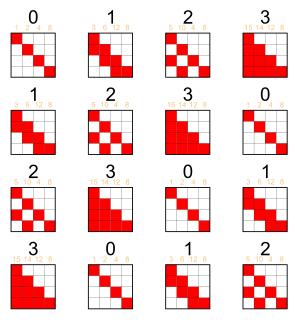In mathematics, the Lie–Kolchin theorem is a theorem in the representation theory of linear algebraic groups; Lie's theorem is the analog for linear Lie algebras.

Mathematics includes the study of such topics as quantity, structure, space, and change.
Representation theory is a branch of mathematics that studies abstract algebraic structures by representing their elements as linear transformations of vector spaces, and studies modules over these abstract algebraic structures. In essence, a representation makes an abstract algebraic object more concrete by describing its elements by matrices and the algebraic operations in terms of matrix addition and matrix multiplication. The algebraic objects amenable to such a description include groups, associative algebras and Lie algebras. The most prominent of these is the representation theory of groups, in which elements of a group are represented by invertible matrices in such a way that the group operation is matrix multiplication.

In mathematics, a linear algebraic group is a subgroup of the group of invertible n×n matrices that is defined by polynomial equations. An example is the orthogonal group, defined by the relation MTM = 1 where MT is the transpose of M.
Contents
It states that if G is a connected and solvable linear algebraic group defined over an algebraically closed field and

In topology and related branches of mathematics, a connected space is a topological space that cannot be represented as the union of two or more disjoint nonempty open subsets. Connectedness is one of the principal topological properties that are used to distinguish topological spaces.

In mathematics, more specifically in the field of group theory, a solvable group or soluble group is a group that can be constructed from abelian groups using extensions. Equivalently, a solvable group is a group whose derived series terminates in the trivial subgroup.

In mathematics, a field is a set on which addition, subtraction, multiplication, and division are defined, and behave as the corresponding operations on rational and real numbers do. A field is thus a fundamental algebraic structure, which is widely used in algebra, number theory and many other areas of mathematics.
a representation on a nonzero finite-dimensional vector space V, then there is a one-dimensional linear subspace L of V such that
In the mathematical field of representation theory, group representations describe abstract groups in terms of linear transformations of vector spaces; in particular, they can be used to represent group elements as matrices so that the group operation can be represented by matrix multiplication. Representations of groups are important because they allow many group-theoretic problems to be reduced to problems in linear algebra, which is well understood. They are also important in physics because, for example, they describe how the symmetry group of a physical system affects the solutions of equations describing that system.

A vector space is a collection of objects called vectors, which may be added together and multiplied ("scaled") by numbers, called scalars. Scalars are often taken to be real numbers, but there are also vector spaces with scalar multiplication by complex numbers, rational numbers, or generally any field. The operations of vector addition and scalar multiplication must satisfy certain requirements, called axioms, listed below.
That is, ρ(G) has an invariant line L, on which G therefore acts through a one-dimensional representation. This is equivalent to the statement that V contains a nonzero vector v that is a common (simultaneous) eigenvector for all .
It follows directly that every irreducible finite-dimensional representation of a connected and solvable linear algebraic group G has dimension one. In fact, this is another way to state the Lie–Kolchin theorem.

In mathematics, specifically in the representation theory of groups and algebras, an irreducible representation or irrep of an algebraic structure is a nonzero representation that has no proper subrepresentation closed under the action of .
Lie's theorem states that any nonzero representation of a solvable Lie algebra on a finite dimensional vector space over an algebraically closed field of characteristic 0 has a one-dimensional invariant subspace.
The result for Lie algebras was proved by SophusLie ( 1876 ) and for algebraic groups was proved by EllisKolchin ( 1948 , p.19).

Marius Sophus Lie was a Norwegian mathematician. He largely created the theory of continuous symmetry and applied it to the study of geometry and differential equations.
Ellis Robert Kolchin was an American mathematician at Columbia University. Kolchin earned a doctorate in mathematics from Columbia University in 1941 under supervision of Joseph Ritt. He was awarded a Guggenheim Fellowship in 1954 and 1961.
The Borel fixed point theorem generalizes the Lie–Kolchin theorem.









